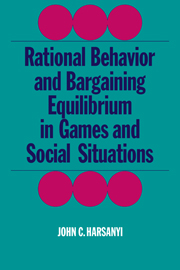Book contents
- Frontmatter
- Contents
- Preface
- Part 1 Preliminaries
- Part II General principles
- Part III Solutions for specific classes of games
- 8 Two-person simple bargaining games: the Nash solution
- 9 General two-person cooperative games
- 10 n-Person simple bargaining games
- 11 n-Person cooperative games with transferable utility: the modified Shapley value
- 12 n-Person cooperative games: the general case
- 13 n-Person cooperative games: discriminatory solutions
- 14 Noncooperative and almost-noncooperative games
- 15 Conclusion
- Notes
- References
- Index
10 - n-Person simple bargaining games
Published online by Cambridge University Press: 24 November 2009
- Frontmatter
- Contents
- Preface
- Part 1 Preliminaries
- Part II General principles
- Part III Solutions for specific classes of games
- 8 Two-person simple bargaining games: the Nash solution
- 9 General two-person cooperative games
- 10 n-Person simple bargaining games
- 11 n-Person cooperative games with transferable utility: the modified Shapley value
- 12 n-Person cooperative games: the general case
- 13 n-Person cooperative games: discriminatory solutions
- 14 Noncooperative and almost-noncooperative games
- 15 Conclusion
- Notes
- References
- Index
Summary
Introduction
In an n-person simple bargaining game the n players have to choose a payoff vector u = (u1,…, un) from a compact and convex set P of possible payoff vectors, called the payoff space of the game. The choice of u must be by unanimous agreement of all n players. If they cannot reach unanimous agreement, then they obtain the conflict payoffs c1, …, cn. The payoff vector c = (c1, …, cn) is called the conflict point of the game. We will assume that c∈P.
That region P* of the payoff space P which lies in the orthant defined by the n inequalities ui ≧ ci for i = 1, …, n, is called the agreement space. Like P itself, P* is always a compact and convex set.
We will exclude the degenerate case where the payoff (s) of some player(s) is (or are) constant over the entire agreement space P*. For in this case this player (or these players) would have on interest in cooperating with the other player(s), and so the game would not be a truly cooperative game.
The set of all points u in the payoff space P undominated, even weakly, by any other point u* in P is called the upper boundary H of P. In other words, H is the set of strongly efficient points in P. In general the payoff space P is a set of n dimensions.
- Type
- Chapter
- Information
- Publisher: Cambridge University PressPrint publication year: 1977



